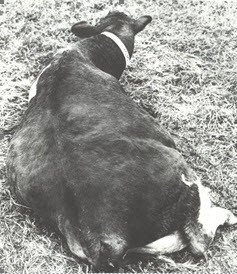Milk fever
Description

|
Milk fever is a condition of mature dairy cows that occurs a few days before, but mostly immediately after calving. It is common in imported high yielding dairy cows, especially Friesian or Channel Island breeds such as Jersey or Guernsey. Milk fever does not occur in indigenous cows.
Milk fever is caused by low calcium levels in the body due to the sudden onset of lactation at calving. The nutritional status of the cow in the dry period is known to influence the risk of the disease. Diets low in dry matter such as lush pastures and diets with high calcium during dry period can predispose the cow to milk fever. Low magnesium in the diet hinders absorption of calcium and hence predisposes the cow to milk fever.
The disease almost only occurs in cows which are in their third lactation or older. It is very rare in calving heifers.
Signs of Milk fever
- The first sign of the disease is loss of appetite, followed by a slight drop in temperature.
- The affected animal become uncoordinated, falls over and remains seated with its head resting on its shoulder.
- Dull eyes and shivering, constipation is a common feature and sometimes a wobbly gait is seen.
- If not treated immediately, the animal may go into coma and die within a day after the first signs. Since the rumen stops functioning, bloat becomes a complication and may cause death
Diagnosis
- Based on history, recent calving or near calving
- Clinical signs and response to calcium treatment
- Blood samples can be taken to the laboratory for calcium and phosphate levels
Diseases with similar symptoms
- Differentiate diagnosis with Ephemeral Fever (please insert link) where the cow goes recumbent (insert dictionary)
Prevention and Control
- Feed the cow with the correct levels of nutrients from late pregnancy to peak lactation
- Feed diets with the right dry matter content such as offering additional hay in combination with lush pasture.
- Feed balanced mineral supplement which appreciates the inter-relationship between calcium, phosphorus and magnesium The minerals for a dry cow should be different from the minerals for a lactating cow.
- Right after successful calving give high yielding cows a handful of agricultural lime mixed with first feed. This will assist the cow in summoning enough calcium to produce milk.
- Let the calf suckle for the first 3-4 days with no extra milking. This will allow the cow to adjust gradually to produce milk. The first colostrum is not marketable anyway.
Recommended treatment
- Be aware of the first signs: the cow has no appetite and becomes cold. Feel the ears, the basis of the horns and the head: if it is cold, the cow is developing milk fever. At this stage, the stomachs of the cow still can work in many cases – not all. If the stomachs work, it can sometimes be successfully treated with fluent calcium in water given in a bottle. If the stomachs do not work, then this is useless, and calcium has to be given as described below.
- If the cow is found to be lying on her side she should be immediately propped on to her chest, otherwise she is liable to get bloat or inhale stomach content with the attendant risk of developing aspiration pneumonia. DO NOT use rocks or boulders to prop!
- Call veterinary immediately
- Slow intravenous infusion 400ml of 20% calcium borogluconate should be administered as early as is possible. If this is difficult then give the same volume by subcutaneous (insert dictionary) injection. Give in several sites and massage the sites of injection to disperse the solution.
- Response to treatment is seen by the cow belching, snapping and opening her eyelids, breathing deeply, passing dung and sitting up.
- Even if the cow appears to be unconscious give intravenous calcium. Even cases which look hopeless can recover.
- The calf should be removed and the cow not milked for 24 hours. On day two milk half the estimated volume from each quarter and feed this to the calf. On day three milk normally. If the calf is allowed unrestrained access to the cow or if unrestrained milking is carried out the cow may well go down again.
- Get a flutter valve and have it clean and ready for use. There is nothing more frustrating than trying to give 400 ml calcium by intravenous injection with a 20 ml syringe and it is guaranteed to damage the jugular vein.
